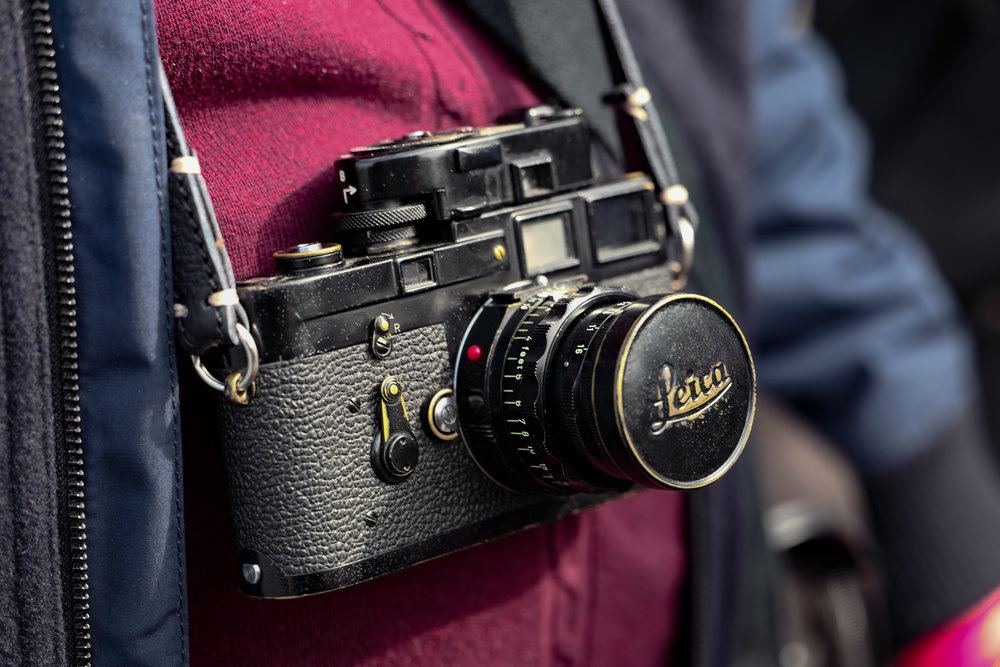
Over at Leicaphilia there’s a bit of a shindig going on about black-paint Leicas. Is the buoyant market for genuine, factory painted black paint bodies about to crash?
We all know that a shiny black paint M3, M2 or M4, is a desirable object commanding a premium. But, because of this, there are many repaint jobs on the market and even the experts find it difficult to tell genuine from modified.
Black chrome bodies, such as my 1970s M4, are also desirable although priced much lower than a genuine black-paint body. In practical terms, black chrome can be more durable and, in a user camera, I think I prefer it. Others prefer the way black paint versions wear, showing the brass underneath. My much more recent 2004 black-paint MP never fails to appeal when I pick it up. There’s just something alluring about a shiny black finish with, as in the case of the MP, a bit of brass showing at wear points.
Because of the premium attached to an old black-paint body, it is very much a case of caveat emptor. I am certainly not qualified to judge the provenance of a 50-year-old camera and I would certainly be wary of buying from auction sites. Some, such as this example which appears to be genuine and comes from a dealer can have eye-watering price tags.
Leicaphilia believes that the market is about to come crashing down. But will it? Whether it is an original factory black paint or a well-done repaint, many buyers will still prefer the finish to mere chrome or black chrome. It’s just a matter of being sure that the price is commensurate with the provenance. A genuine factory black-painter, such as the one shown above, is worth much more than a repaint job and, for the unwary, it is easy to make expensive mistakes.
You can read the full article and comments here.
And 15 clues your black-paint Leica could be a fake
_______________
- Subscribe to Macfilos for free updates on articles as they are published. Read more here
- Want to make a comment on this article but having problems? Please read this

Colour preference is only part of the story here. Rarity and originality and desirability are also factors. Collectiblend shows that black paint Ms are continuing to grow in value when auctioned with a black paint lens. Body only sales show a bit of a flattening of the curve, but are still holding their value. I am talking about about real original items here, not something knocked up or re-painted by some bloke in Japan or somewhere else. Perfect looking examples are often treated with suspicion. Nobody who is interested in value preservation should ever have a genuine black paint example re-painted.
Real black paint models are probably ‘over-valued’ and there could be some ‘market correction’ in the future. Auctions are a true market place as they determine what collectors are prepared to pay for rare and/or desirable items. Not surprisingly, given the huge price differential there are also fraud items around where someone has deliberately repainted a chrome camera and has then had it aged with brassing etc. The collectors group on the Leica Forum are forever vigilant about such matters and whenever a previously un-documented black paint M3 or M2 appears on eBay or elsewhere, the ‘Leica Police’ are on the job. In many cases the eBay listing gets withdrawn. Caveat emptor applies and caution is advised. Anyone interested should only deal with reputable dealers and auction houses.
As Stephen recounts my own preference is for the black lacquer with nickel furniture models made between 1925 and about 1936. They are generally much cheaper than the Black Paint Ms, of course. To wrap up, is ‘market correction’ possible? I would say yes, but when and by how much is difficult to predict. If one serious fraud with a BP M gets wide-scale publicity, that could be the trigger for such a correction. So the guys on the Leica Forum are doing a good job at preventing this.
William
I prefer black cameras, I really don’t care whether the blackness is effected by painting, enamelling or anodising, somehow they don’t shout "look at my camera".
One of the reasons that I sold both my Fuji x100s and my Leica x2 was that I did not like the chrome, I put up with my M2, since there is a premium for black ones, genuine or not, but it was really easy to sell it.
Unless one is a collector rather than a user, it shouldn’t matter whether someone other than Leica has painted your camera. For the collectors, genuine rarity can be found in many other aspects of Leica history…
… As William Fagan both a collector and an avid Leica user, has written in his pieces for this blog, like this:
https://www.macfilos.com/photo/2016/1/17/leica-cameras-in-the-1930s-a-decade-of-progress?rq=fagan
Apart from that, collecting is a moving target, what was once desirable only remains that way as long as people are prepared to take a punt.
Finally, if someone is selling something that appears to be too good to be true, it usually is, so this game is for people like William who really know their stuff.
As was pointed out on the leicaphilia site…
Caveat Emptor, always.